Introduction to the Characteristics and Secrets of Mimosa
Last Update :2024.04.21
Article Catalog
Mimosa is a perennial herb or subshrub of the Leguminosae family. It is named because its leaves will automatically close when stimulated. It is about one meter tall, with a cylindrical stem. Its leaflets are generally symmetrically distributed, with about ten to twenty pairs, with sharp tips, and the entire shape is like a feather. Its flowers are in the form of flower heads, with a plush appearance, relatively small, white or pink in color, and bell-shaped calyxes. The overall look is very delicate and cute, and has good ornamental value.

1. Characteristics of Mimosa
1. Characteristics of Mimosa
Shape: Mimosa is a perennial herb or subshrub of the Leguminosae family, about one meter high. Its stem is cylindrical and has many branches. Its stipules are lanceolate and approximately five to ten millimeters in length. Its leaflets are generally symmetrically distributed, with about ten to twenty pairs, with sharp tips, and the entire shape is like a feather.
Flowers: The flowers of Mimosa are in the form of flower heads, with a plush appearance, white or pink in color, relatively small in size, and its calyx is bell-shaped. Overall, it looks very delicate and cute. Good viewing value. The flowering period is usually in September.

Pods: The pods of Mimosa are generally oblong Shape, between one and two centimeters in length, about five millimeters in width, relatively flat and slightly curved. There are seeds inside, which are egg-shaped and about 3.5 mm in length.
Reaction: Mimosa is named after its leaves that automatically close when exposed to external stimuli. After closing, they will slowly open again. However, if it is stimulated too much, it may feel "bored" and no longer want to react to external stimulation. The specific reason is that the cell fluid in the parenchyma cells in the leaf pillow is lost too quickly and cannot be replenished in time.

2. Secret introduction
The reason why Mimosa pudica reacts to external stimuli lies in a special organ of it. This organ is called the lobe. The petiole contains many parenchyma cells. Whenever there is an external stimulus, the cell fluid in the parenchyma cells in the upper part of the leaf pillow will be discharged into the intercellular space. In this way, the turgor pressure in the upper part of the leaf pillow will be greatly reduced, but The turgor pressure in the lower half remains unchanged, which causes the two small leaves to close, and sometimes the entire leaf droops. When the cell fluid returns, the leaves will reopen and return to their original shape.

2.Secret introduction
- END -
The flower language and meaning of taro, who should it be given to?

The flower language of tarantula means mutual help, because it is a climbing plant...
Six stages of flower growth

1. Germination stage: The first thing flowers go through during their growth is th...